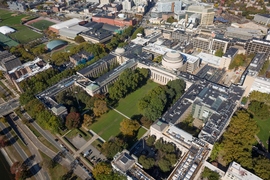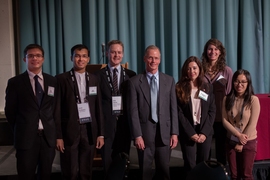This month, the MIT Climate CoLab, in collaboration with Nike, Inc., launched a new competition called Materials Matter. This competition seeks physical, social, and cultural innovations that could help transform the way we view, make, and use materials. This could include ways to affect consumer behavior and design choices, as well as ways to impact the supply chain.
This competition was inspired, in part, by a recent report released by a team of researchers within MIT’s Department of Materials Science and Engineering (DMSE) and MIT’s Materials Systems Laboratory (MSL). The report quantifies the environmental impacts of four key apparel materials: cotton, leather, polyester, and rubber. The team includes Randolph Kirchain, MSL principal research scientist, and Elsa Olivetti, the Thomas Lord Assistant Professor of Materials Science and Engineering, as well as T. Reed Miller and Suzanne Greene, former research specialists with MSL. The report details the environmental impacts of materials throughout the supply chain and tries to contextualize these impacts by comparing them with other common activities like driving or power generation.
The idea for this report came from conversations with Nike about how to stimulate innovation around materials. Unlike more traditional research, the researchers’ ultimate goals for this report are to inspire dialogue among stakeholders and encourage improvements. As Kirchain notes, much of MSL’s research aims to “drive better materials decisions.” To do that, decision makers need “to know where the acute challenges are and to have alternatives solutions from which to choose.”
Olivetti, Kirchain, and several co-authors had also written a 2013 paper on the reduction of carbon emissions caused by the footwear manufacturing process.
The new report presents some of the major environmental impacts of the apparel industry worldwide. For example, a rough analysis from 2009 estimates that the global apparel industry consumes nearly 1 billion kilowatt hours of electricity or 130 million tons of coal, making the apparel industry a significant contributor to global greenhouse emissions. In 2010, the global apparel industry produced more than 150 billion garments — enough to provide more than 20 new articles of clothing to every person on the planet.
In 2015, the global apparel industry is expected to produce more than 400 billion square meters of fabric per year, representing nearly enough material to cover the state of California (or nearly two times of the United Kingdom) annually. Specifically, the greenhouse gas emissions for cotton, polyester, and leather — three of the four materials reviewed in the recent report — make up a significant portion of the total emissions from materials in the apparel industry.
Additionally, the new report notes that water is a key resource used in the textiles industry. In 2009, The New York Times reported that several dozen gallons (or more than 400 pounds) of water were required to process just one pound of textiles.
To submit your ideas on how to shift the way we make, view, and use materials, visit the Materials Matter contest site. Winners receive a $10,000 prize. Don’t have an idea? Comment on or support the proposals that have been submitted. The contest entry deadline is Jan. 29, 2016.









